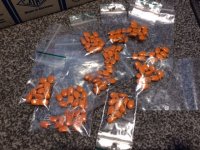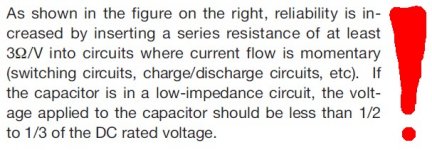i am interested in using tantalum caps for dc blocking on single ended output of audio signal for small headphone amlifier.if i want this device to work for as much years as possible(so no electrolytics to dry and no place for large film caps) ,is it ok for that purpose? it seems that it shouldnt be problem as they are all time polarised and only care should be that audio signal never reaches 0v or less,which wont happen because of se output of said device.
there is lot of bad things written on forums for tantalum caps but i think this could be one very nice use of them and cant find more info about this topic.
there is lot of bad things written on forums for tantalum caps but i think this could be one very nice use of them and cant find more info about this topic.
Modern tantalium and niobium caps can perform fine. In the past (at least 15 years ago) they were as described but times have changed. Most of us have experienced the then unreliable drop type tantalium caps that shorted, exploded and when they worked they sounded terrible. Nowadays the industry uses them a lot. Every smart phone has them. AVX TPS series are very good for instance. The sources for coltan are dubious however as it is mainly found in african countries that have civil wars and the material was often traded for arms in the past. Some manufacturers swear they buy coltan from reputable sources....but we know the same stories of other resource materials. Some governments have no problem selling it and some countries have no problems obtaining it from flaky sources certainly when stuff is used in military devices. Just Google on how a large country got hold of titanium.
Not tantalium but also unusual in audio are the BC solid aluminium caps which are hard to find and meanwhile some series have been discontinued. Not cheap but these have some good audio properties like being able to be reverse polarized (coupling in DC circuits) and they are dry caps too.
Which values do you need and what sizes are they ?
Not tantalium but also unusual in audio are the BC solid aluminium caps which are hard to find and meanwhile some series have been discontinued. Not cheap but these have some good audio properties like being able to be reverse polarized (coupling in DC circuits) and they are dry caps too.
Which values do you need and what sizes are they ?
Last edited:
i am interested in using tantalum caps for dc blocking on single ended output of audio signal for small headphone amlifier.
Use a solid tantalum type of a voltage rating higher than the power supply voltage.
http://www.vishay.com/capacitors/tantalum/low-esr/
Polymer electrolyte caps are also a worthwhile option: they are dry, and exist for both aluminum and tantalum, and do not have the quirks of traditional tantalum.
Their performance is in general outstanding, except perhaps for a few minor characteristics, which are not relevant to this application
Their performance is in general outstanding, except perhaps for a few minor characteristics, which are not relevant to this application
Polymer caps are fine caps indeed. As I was reading last posts I just checked my "rare parts" stock. I do seem to have more solid aluminium SAL-RPM caps than I will ever need. I think I will put these in Swap Meet. Also still some Wima ultra rare 22 µF 16V 5 mm (!!!!) MKS2-XL film caps and a large quantity Black Gate caps of various series. Just bought a few 2SJ74 last week to discover today I have them in stock myself 
Attachments
Last edited:
Tantalum Bead capacitors were notorious for going short circuit. The reason was designers using 12v capacitors on 5V supplies. They need the full voltage across them to keep going. Just like a NiCad battery.
They have excellent HF rejection when used as decoupling on HT rails.
They have excellent HF rejection when used as decoupling on HT rails.
interesting stuff, i am actualy already testing avx d case of kemet 100uf 6.3vhttp://capacitoredge.kemet.com/capedge2/intellispec.jsp?pn=T491D107K006AT&displayPN=T491D107K006AT. thing is that i first read about tantalum caps from manufacturer datasheets and hoped i figured it is good ,but later i found lot of bad things on forums,this is new batch of kemet branded caps that is supposedly reputable manufacturer.
i did tested this on my akgs but after reading i was afraid little so i must ask people who know better.
what can i do to test this caps for failure, to see if they fail short circuit or open?
how to simulate long term use?
i do have lot 10v 47uf film 1206 smd caps at hand but dont think could fit 2 on place of one avx-d on pcb ,and i prefer to use this pcbs i made already.
i did tested this on my akgs but after reading i was afraid little so i must ask people who know better.
what can i do to test this caps for failure, to see if they fail short circuit or open?
how to simulate long term use?
i do have lot 10v 47uf film 1206 smd caps at hand but dont think could fit 2 on place of one avx-d on pcb ,and i prefer to use this pcbs i made already.
One of the failure mechanisms of older type tants was using them on a supply of already very low impedance (which is different to creating a supply of low impedance using tants). They could not absorb high dv/dt transients and this can lead to failure.
Just googling 'failure modes of tantalum capacitors' turns up a nice little pdf from Digikey:
http://www.digikey.co.uk/Web Export/Supplier Content/AVX_478/PDF/AVX_failure.pdf
Just googling 'failure modes of tantalum capacitors' turns up a nice little pdf from Digikey:
http://www.digikey.co.uk/Web Export/Supplier Content/AVX_478/PDF/AVX_failure.pdf
Attachments
Hi isn't that specific information regarding NEC Tokin tantalum capacitors ? They also confirm what is said about voltage ratings : "For general applications, apply 70% or less of the rated voltage to the capacitor."
BTW I found this when trying to find scientific proof that reliability of tantalum caps has vastly improved and found this:
https://nepp.nasa.gov/docuploads/0E...alum Polymer Capacitors FY05 Final Report.pdf
BTW I found this when trying to find scientific proof that reliability of tantalum caps has vastly improved and found this:
https://nepp.nasa.gov/docuploads/0E...alum Polymer Capacitors FY05 Final Report.pdf
Last edited:
They need the full voltage across them to keep going.
We had large custom instrumentation systems with 16V tantalums operating on regulated 15V.
Nearly all of them failed after a few years.
20 years ago tantalum caps nearly all failed.
You can say that again.
Now it is 2016 and we can use them with confidence. The industrial processes have been improved and higher purity tantalum powder is used. It really surprises me that a bad reputation is so hard to get rid of. I must say tantalum caps then were a phenomenon everybody in electronics knew as they tended to go with a small explosion.
Sometimes A brand electrolytic cap manufacturers make a mistake which results in blown caps (like Nichicon) but no one seems to bring that up again. Tantalum caps seem like having tattoos, you can't get rid of the reputation.
Sometimes A brand electrolytic cap manufacturers make a mistake which results in blown caps (like Nichicon) but no one seems to bring that up again. Tantalum caps seem like having tattoos, you can't get rid of the reputation.
Last edited:
Tantalum caps seem like having tattoos, you can't get rid of the reputation.
When they went, often the pcb would have a big burned area, requiring replacement of the entire pcb,
not to mention it being a fire hazard. The old saying was very appropriate: once burned, twice shy.
My experience
Modern tantalum capacitors
Allow great flexibility in designing power supplies
Because of the wide range of ESR
There are many places in the design of voltage regulators have limitations that can only tantalum capacitors
To provide a solution.
Examples
In LM317 output capacitors
need the cap to be not too Low ESR
and only Tantalum can give a solution
one more advantage in tantalum cap is law DCL
In converters from Analog to Digital
There is also an advantage because DCL
v-com (internal bias decoupling pin)
leakage current in the capacitor its effect on the gain error.
Tantalum capacitors have very low DCL.
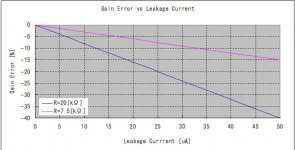
good tantalum witt law esr -examples
Vishay series
T55
592D 593D 594D
AVX series
T4J
TRJ
Of course there are more exotic tantalum capacitors such as that of AVX
But that's a story for another thread
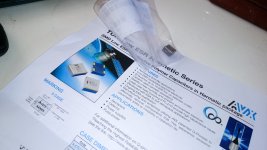
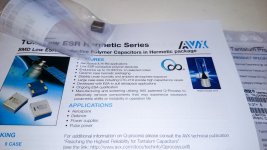
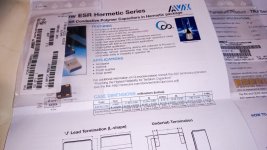
Best regards David Az
Modern tantalum capacitors
Allow great flexibility in designing power supplies
Because of the wide range of ESR
There are many places in the design of voltage regulators have limitations that can only tantalum capacitors
To provide a solution.
Examples
In LM317 output capacitors
need the cap to be not too Low ESR
and only Tantalum can give a solution
one more advantage in tantalum cap is law DCL
In converters from Analog to Digital
There is also an advantage because DCL
v-com (internal bias decoupling pin)
leakage current in the capacitor its effect on the gain error.
Tantalum capacitors have very low DCL.

good tantalum witt law esr -examples
Vishay series
T55
592D 593D 594D
AVX series
T4J
TRJ
Of course there are more exotic tantalum capacitors such as that of AVX
But that's a story for another thread



Best regards David Az
Last edited:
- Status
- This old topic is closed. If you want to reopen this topic, contact a moderator using the "Report Post" button.
- Home
- Design & Build
- Parts
- Tantalum caps DC block
